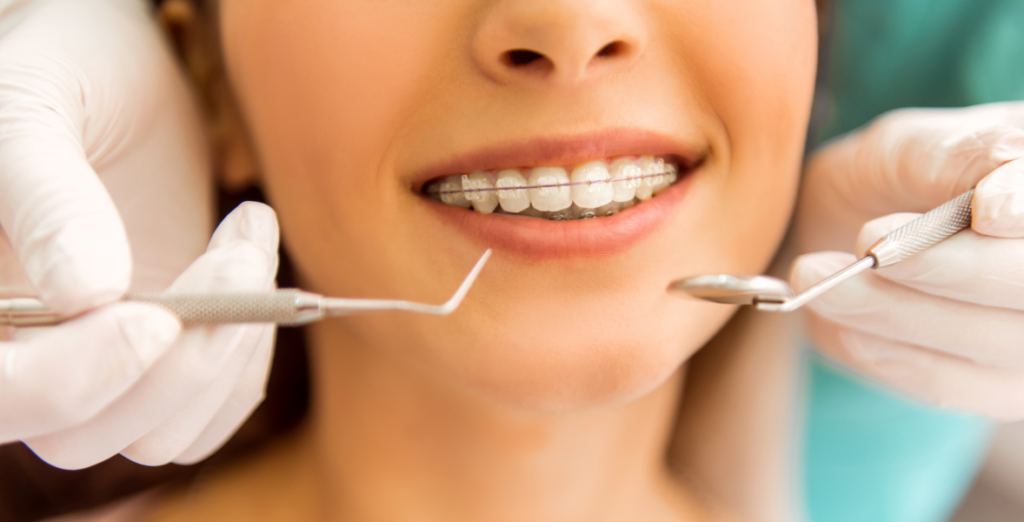This treatment is for you if…
You require a short-term treatment to align your teeth.
This type of orthodontics has been replaced by aesthetic alternatives that offer better advantages, such as invisible orthodontics. If you need a treatment with brackes technique, metallic brackets are the ideal option.
What are resin brackets?
Resin brackets, also known as polycarbonate brackets, are among the most aesthetic braces in the world of orthodontics, since the materials used are virtually transparent.
Resin brackets are the least expensive treatment within the so-called aesthetic brace category. These brackets are made of a transparent material similar to plastic.
They are ideal for patients that need a treatment that lasts a short time since, aside from their price, the results obtained are the same as those obtained by other types of brackets such as metallic ones.
Advantages of resin brackets
Aside from their aesthetics, resin brackets have various advantages with respect to other types of braces.
- More aesthetic.. Compared with all aesthetic brackets, the materials with which resin brackets are made are those which go the most unnoticed. This is due to the fact that polycarbonate is a type of transparent plastic that lets part of the light pass through it and does not change the tone of the teeth when it is attached to their base.
- More economical. The materials with which the resin brackets are made are usually more accessible than those used in other orthodontic procedures. That means that the treatment is cheaper than other aesthetic techniques.
- More comfortable. Resin brackets have no sharp points or edges. Thanks to this, the patient will not suffer any of the common discomfort of other treatments, such as mouth ulcers, swollen gums or tongue injuries that are so common to metallic brackets.
Resin brackets can also be used by people that have an allergy to or rejection of metal such as nickel, a type of alloy normally used in traditional metallic brackets.

Other characteristics of resin brackets to be taken into account
Despite the fact that resin brackets have many advantages, just like all orthodontic treatments, there are certain characteristics that the patient must be aware of before deciding the final technique:
- Fragility. Polycarbonate is a material that perfectly performs its function in the world of orthodontics. However, it is necessary to take into account that resin brackets are not as tough as metal or ceramic brackets. Since they are more fragile, resin brackets may suffer wear and tear or break more easily.
- Recommended for short treatments. Orthodontic treatment with resin brackets is usually recommended for patients that require a shorter less intense treatment. The material with which these brackets are made cannot endure long procedures, hence the resin brackets may become deformed or stained if the durability of the treatment is exceeded.
Orthodontic treatment phases using resin brackets
Orthodontic treatment with resin brackets has virtually the same phases as other treatments. Its five stages are as follows:
1. Orthodontic study. The first appointments are earmarked to a patient study, using the corresponding dental x-rays and photographs. Once this step is complete, their orthodontic treatment will be planned on a personalised basis.
2. Fitting of brackets. The next step is placing the brackets on and cementing them to the patient’s teeth. Once the brackets have been fitted, the patient must take note of the dentist’s instructions regarding the care and maintenance required for this type of brackets.
3. Frequent check-ups. These check-ups allow the orthodontist to assess the process and improvements to the treatment, adjusting the resin brackets to obtain greater effectiveness. At the appointments, any polycarbonate parts damaged, either by accident or by the movement of the teeth, can be replaced.
4. Removal of resin brackets. Treatments involving resin brackets are usually shorter and may last from six months to one year, depending on each case. When the objectives set at the first visit have been attained, the dentist will remove the resin parts and the arches. Afterwards, all teeth will be fully cleaned to eliminate any remains of cement and accumulated dirt.
5. Fitting of retainers. As with other types of orthodontic treatments, retainers are usually fitted once the resin brackets have been removed. This is because the teeth ligaments must assimilate the change of the new distribution.



